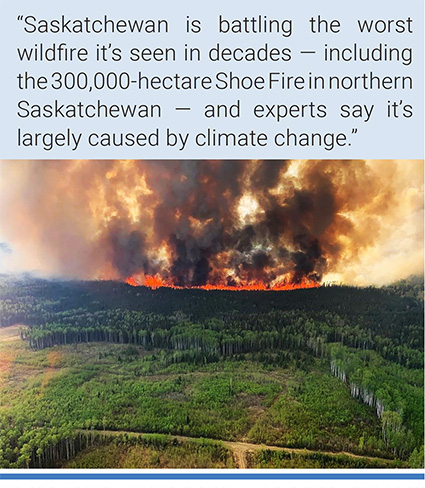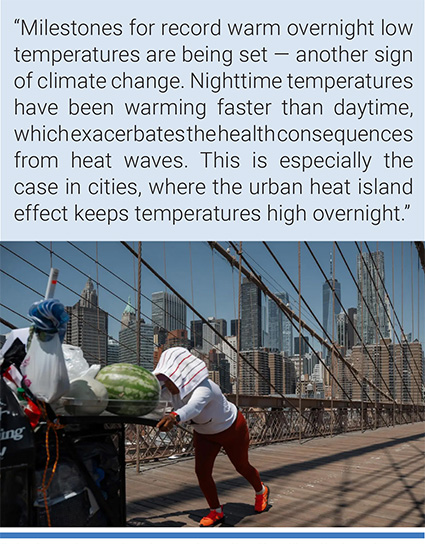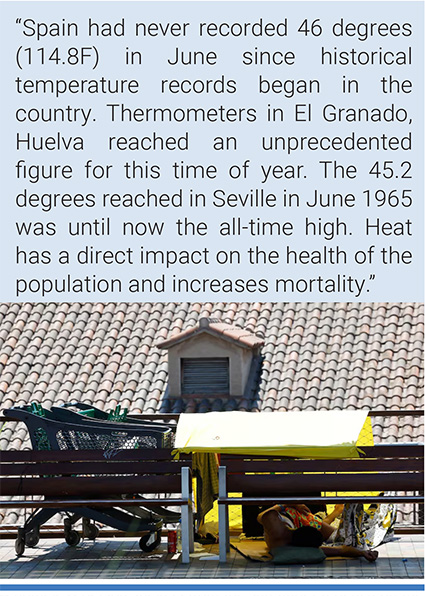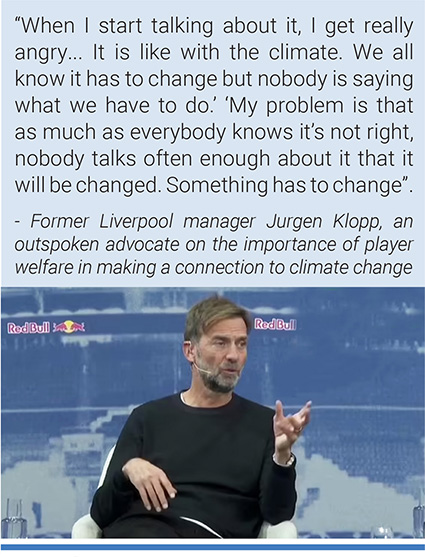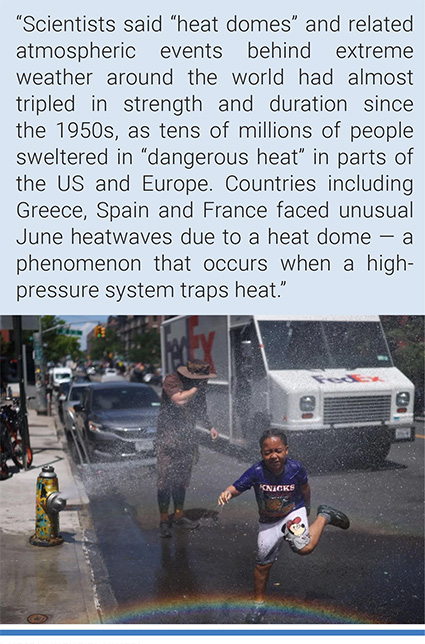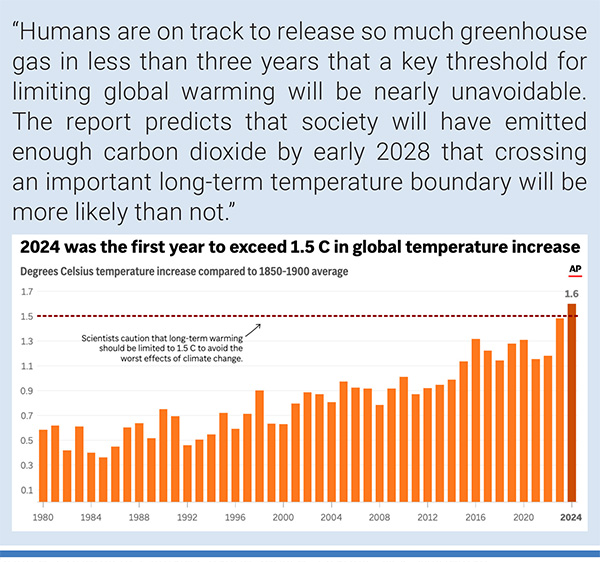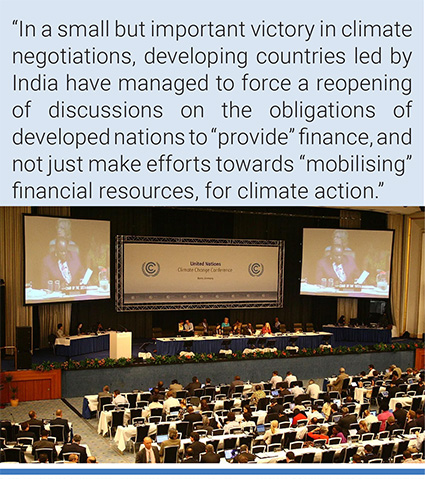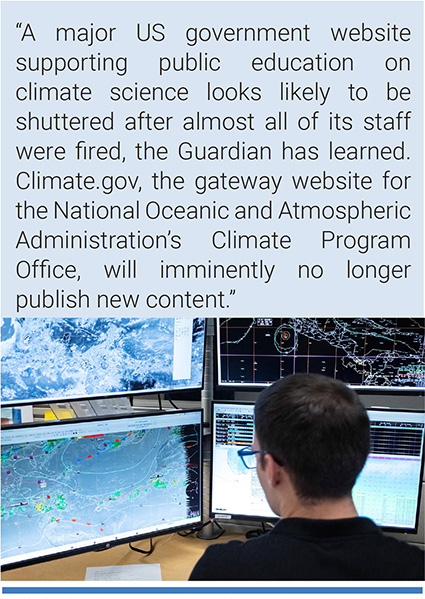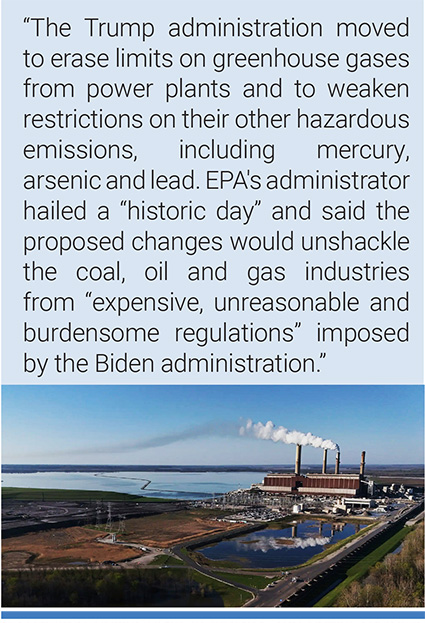Monthly Summaries
Issue 102, June 2025 | "Something has to change"
[DOI]
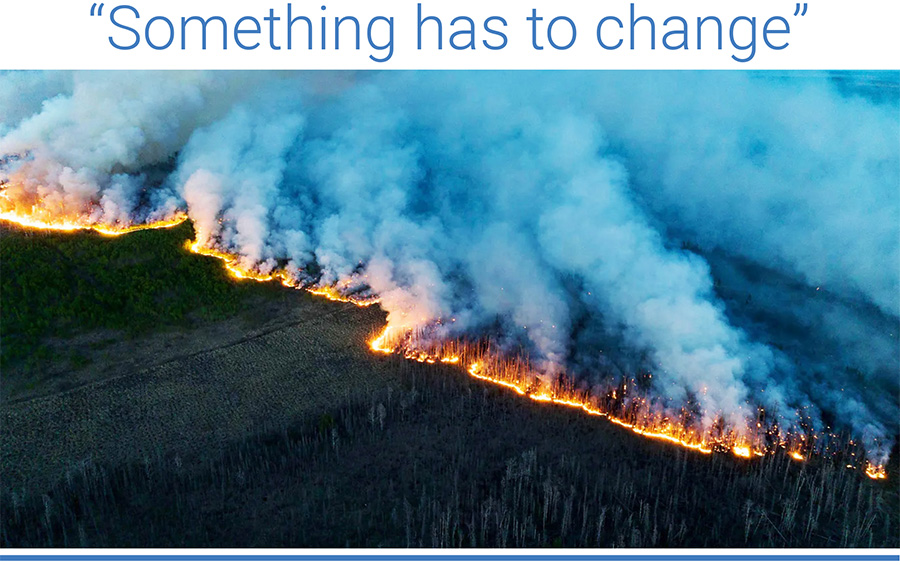
Canada has seen weeks of unprecedented wildfires, with thousands of people evacuated. Photo: Alamy.
June media coverage of climate change or global warming in newspapers around the globe dropped 6% from May 2025, while it was markedly down 28% from June 2024. Meanwhile, international wire services increased 9% from May 2025 but still decreased 26% from June 2024. Figure 1 shows trends in newspaper media coverage at the global scale – organized into seven geographical regions around the world – across 21.5 years, from January 2004 through June 2025.

Figure 1. Newspaper media coverage of climate change or global warming in print sources in seven different regions around the world, from January 2004 through June 2025.
At the regional level, June 2025 coverage – compared to the previous month – stayed steady in the Middle East while it went up 4% in Asia as well as up 17% in Africa. However, coverage went down in Latin America (-3%), North America (-7%), Europe (EU) (-12%), and Oceania (-43%). Comparing these June 2025 levels of coverage to a year previous (June 2024), counts decreased in all regions: in the Middle East (-3%), North America (-7%), Latin America (-13%), Asia (-16%), Africa (-25%), the EU (-35%), and Oceania (-54%). As an example, at the country level of coverage that we at the Media and Climate Change Observatory (MeCCO) monitor, coverage in Canada in June 2025 increased 24% from May 2024 but remained 19% lower than levels of coverage in June 2024 (see Figure 2).

Figure 2. Canadian newspaper coverage – in Globe and Mail, Toronto Star, and National Post – of climate change or global warming from January 2000 through June 2025.
The Bald Mountain Wildfire is shown in the Grande Prairie Forest Area on Friday May 12, 2023 this handout image provided by the Government of Alberta. Photo: HO /The Canadian Press. |
In terms of content, there were many ecological and meteorological-themed media stories carried in outlets in June. To begin the month, in Canada and in the United States (US) there were growing concerns about heat and wildfire activity in the West. For example, reporting in Le Monde shared, “Canada's wildfires, which have already forced the evacuation of more than 26,000 people, continued their stubborn spread on Tuesday, June 4, with heavy smoke choking millions of Canadians and Americans and reaching as far away as Europe. Alerts were issued for parts of Canada and the neighboring United States, warning of hazardous air quality… Climate change has intensified the impact of extreme weather events in Canada, which is still recovering from the apocalyptic summer of 2023 when 15 million hectares of forests were scorched. As of Tuesday, there were 208 active fires across Canada. Half of them were listed as out of control, according to the Canadian Interagency Forest Fire Centre. Many of the affected populations are Indigenous, and some small communities have been burned to the ground”. As a second example, CBC News reporter Aliyah Marko-Omene wrote, “Saskatchewan is battling the worst wildfire it's seen in decades — including the 300,000-hectare Shoe Fire in northern Saskatchewan — and experts say it's largely caused by climate change. "This is classic climate change," said Colin Laroque, head of soil science and professor at the University of Saskatchewan. Laroque said climatology is studied using 30-year timeframes of weather patterns, which "weren't that different" until recently… Lori Daniels, professor and researcher at the University of British Columbia's department of forest and conservation sciences, said the emergency wildfire situation in the province is the result of an emergency global climate situation. "The further we are from the equator, we're seeing that those changes are amplified," Daniels said. "In Northern Canada and the northern parts of our provinces and up into the territories … we're experiencing more than three times what the global average is in terms of temperature change." Daniels said climate change is "the new reality" and it's unclear how long the province will be dealing with these fires”. As a third example, writing for The Guardian Eric Holthaus noted, “Unusually warm springtime temperatures have contributed to rapid reductions in snowpacks across the western US that rival the fastest rates on record, increasing concerns around wildfire season. The rapid snowmelt, in addition to reduced staffing and budget constraints initiated by the Trump administration, has set the stage for a particularly dangerous season across the west, according to an analysis of publicly available data by the Guardian and interviews with experts in the region. The National Weather Service has issued flash flood warnings across the south-west this week as warm weather ushered in rainfall at higher-than-usual elevations, worsening the runoff. In several lower-elevation locations within the headwaters of the Colorado River, mountain terrain is already snow-free – the earliest complete melting of snowpack on record…The rapid onset of summer-like conditions is a clear symptom of the climate crisis, and it has been occurring more frequently in the western US in recent years. There are more than a million homes in the wildland-urban interface in Washington state – about the same as in southern California – and the number is growing quickly”.
Wildfire activity – with links to climate change – generated concern and news coverage in other regions on the planet as well. For example, in Greece BBC journalist Nikos Papanikolaou reported, “A large wildfire swept through the coastal towns of Palaia Fokaia and Thymari 40 km (25 miles) southeast of Athens, destroying homes and forcing evacuations as it neared the beach. The flames erupted in low vegetation but quickly spread into residential areas, as Greece experienced its first heatwave of the summer. At least 20 homes were destroyed and many others suffered structural damage, according to local officials. Strong winds and soaring temperatures of up to 40°C made the fire extremely difficult to control… Greece has sought to beef up its response to wildfires, which have become increasingly common because of its long, hot summers and warming climate”.
June coverage also involved new information about how fire devastated more of the Amazon in 2024 than at any time in 40 years. For example, El País journalist Naiara Galarraga Gortázar wrote, “We now know that the fire that devoured South America last September, just as the Southern Hemisphere entered spring, caused historic devastation in the Brazilian Amazon. In 2024, intentional fires scorched more of the world's largest rainforest than at any time in the past 40 years, according to satellite measurements. The flames burned exactly 156,000 square kilometers of rainforest, according to the report presented by Mapbiomas, a Brazilian organization comprised of universities, NGOs, and technology companies. That's more than all of Greece. According to Mapbiomas, this explosion of Amazon fires is due to intentional fires to open new pastures, aggravated by a historic drought and other effects of climate change. The fires in the Amazon were only half of those suffered in Brazil. But the damage could be severe or very severe. The report adds that two-thirds of the area burned in the country over these four decades was native vegetation, the most resilient and the most effective contributor to mitigating global warming”.
A fruit vendor pushes her cart on the Brooklyn Bridge during a heatwave in New York. Photo: Olga Fedorova/AP. |
In mid-June, a heat wave across North America made news as several stories made links with a warming planet. For example, at CNN journalist Andrew Freedman wrote, “The intensifying and expansive heat wave affecting around 150 million people in the United States from Wisconsin to Washington, DC, bears the hallmarks of human-caused global warming. Hundreds of daily temperature records are threatened during the next few days, particularly along the East Coast, and some all-time June high temperature records could be tied or broken as well. Milestones for record warm overnight low temperatures are also being set — another sign of climate change. Nighttime temperatures have been warming faster than daytime, which exacerbates the health consequences from heat waves. This is especially the case in cities, where the urban heat island effect keeps temperatures high overnight. The US heat wave comes nearly in tandem with searing high temperatures in Western Europe, which global warming made far more likely and intense. Of all the forms of extreme weather — droughts, floods, hurricanes — heat waves are the ones that scientists can most reliably tie to climate change caused by fossil fuel pollution. As the world warms, the odds of extreme heat events increase dramatically, while the odds and severity of record cold extremes decrease”. Meanwhile, Guardian correspondent Edward Helmore noted, “The list of climate-related disasters in the US was long last week as vast swathes of America sweated under a brutal heatwave. There was a “mass-casualty event” of fainting high-schoolers in New Jersey as a K-pop concert was cut short in Washington. Young hikers had to be rescued in New Hampshire as tarmac roads bucked and melted in South Dakota and Nebraska. Luckless Amtrak passengers were stuck on a train with no air conditioning in a Baltimore tunnel, while some subway services in New York were suspended. The Trump administration declared a power emergency in the US south-east, and in Georgia the agriculture commissioner advised residents to make sure their animals had water and shade. These incidents – and many more – were the result of the highest temperatures across the northern and middle swath of the US at this early summer date in some cases since the late 19th century. Nearly 130 million people were under extreme heat warnings or heat advisories on Thursday, according to NOAA’s Weather Prediction Center, with 282 locations breaking daily heat records this week, with another 121 equaling with previous highs, NOAA data showed. Daily heat records were set in at least 50 cities in the eastern US on Tuesday alone, according to the National Weather Service, with New York City recording its hottest day since 2012, according to NOAA. Climate scientists blamed a rapidly warming Arctic for the heat dome – a consequence that they say is the result of the “stuck” weather patterns that come from a wavier polar jet stream, which can cause not just heatwaves but also heavy rainfall and floods”. Elsewhere, New York Times journalists Achi Kitajima Mulkey, Claire Brown and Mira Rojanasakul reported, “Summer started barely a week ago, and already the United States has been smothered in a record-breaking “heat dome.” Alaska saw its first-ever heat advisory this month. And all of this comes on the heels of 2024, the hottest calendar year in recorded history. The world is getting hotter, faster. A report published last week found that human-caused global warming is now increasing by 0.27 degrees Celsius per decade. That rate was recorded at 0.2 degrees in the 1970s, and has been growing since. This doesn’t surprise scientists who have been crunching the numbers. For years, measurements have followed predictions that the rate of warming in the atmosphere would speed up. But now, patterns that have been evident in charts and graphs are starting to become a bigger part of people’s daily lives”.
A homeless person shelters from the sun under a bench on the Rambla de Sants in Barcelona, Spain. Photo: Toni Albir/EFE. |
A heat wave in Europe also generated news that linked the warmth to a changing climate. For example, Guardian correspondent Sam Jones wrote, “Authorities across Europe are on alert as the first heatwave of the summer pushes temperatures up to 42C (107.6F), as the fastest-warming continent continues to suffer the effects of the climate emergency. Spain’s state meteorological office, AEMET, issued a special heat warning on Friday, saying temperatures could reach 42C in some southern areas of the country over the coming days. “Very high and persistent temperatures are expected, both during the day and at night, which could pose a risk to exposed and/or vulnerable people,” AEMET said. Madrid’s health ministry also warned people to take extra care in the heat, reminding them to stay out of the sun, keep hydrated and pay close attention to those who are older, pregnant or who have chronic health conditions. Two-thirds of Portugal will be on high alert on Sunday for extreme heat and forest fires as temperatures of up to 42C are expected in Lisbon. As temperatures in Marseille approach 40C, authorities in France’s second-largest city have ordered public swimming pools to be made free of charge to help residents beat the Mediterranean heat. With peaks of 39C expected in Naples and Palermo, Sicily has ordered a ban on outdoor work in the hottest hours of the day, as has the Liguria region in northern Italy. The country’s trade unions are campaigning to extend the measure to other regions. In Venice – which has played host to the lavish three-day wedding celebrations of Amazon founder Jeff Bezos and his wife, Lauren Sánchez, guests, visitors and protesters are feeling the heat”. As a second example, El País journalists Oriol Güell, Jacob Vicente y Montse Hidalgo Pérez noted, “Spain had never recorded 46 degrees in June since historical temperature records began in the country. Until this Saturday, when thermometers in El Granado (Huelva) reached an unprecedented figure for this time of year, according to the State Meteorological Agency (AEMET). The 45.2 degrees reached in Seville in June 1965 was until now the all-time high. Heat has a direct impact on the health of the population and increases mortality”.
Source: Daily Mail Online. |
Several cultural-themed stories relating to climate change or global warming were evident in media accounts. To begin, the Club World Cup that kicked off in the US generated media attention as players and fans were subjected to hot temperatures at match times. For example, Daily Mail journalist Zac Campbell reported, “Former Liverpool manager Jurgen Klopp has slammed the current Club World Cup as 'the worst idea ever in football' in a brutally honest swipe at FIFA. Klopp, 58, appeared to be wholly unimpressed with the path taken by the sport's decision-makers to introduce a newly-expanded 32-team format this summer. The tournament, which is currently being held in the United States, has come in for heavy criticism for adding to what many players and managers believe to be a saturated schedule…The German, who is now Red Bull's global chief of football, was an outspoken advocate on the importance of player welfare during his time as Liverpool manager. In August 2022, he compared the issue of player welfare to climate change ahead of that year's World Cup taking place mid-season in Qatar. He said at the time: 'If you go to the final at a World Cup and win it or lose or a third-place match you are already quite busy and then the rest starts a week later. 'If all the players then have a break it is not a problem, it is good. It is like a winter break which I had that in Germany as a player a lot, four weeks (off), stuff like that. 'When I start talking about it, I get really angry... It is like with the climate. We all know it has to change but nobody is saying what we have to do.' 'My problem is that as much as everybody knows it's not right, nobody talks often enough about it that it will be changed. Something has to change”. As a second example, CBS News sports reporter Pardeep Cattry wrote, “Each and every one of those teams was caught in the middle of USA's summertime weather extremes, all of which will likely play a big part at next summer's World Cup co-hosted by the country, as well as Canada and Mexico. It will add an extra layer of accommodation and preparation for the teams that make the trip, be it for this year's tournament or next year's. The climate realities are somewhat unique to the country, even if the heat issues remind one of Qatar's conditions that paved the way for the first winter World Cup. By selecting North America as the host for next year's World Cup, FIFA will have to deal with the unavoidable climatic realities, though some are of their own creation…Lightning-related delays fall in the former category, a natural result of hot and humid temperatures that are a hallmark of American summers. There is a reason why Florida and Texas, two states that will host matches at next summer's World Cup, are sometimes known as the U.S.' "lightning capitals" — few places are as steamy as those in the summer months, though researchers suggest climate change could increase the number of lightning strikes across the country”.
Photo: Financial Times. |
In the UK, the hottest opening day on record (June 30) at the Wimbledon tennis tournament generated news coverage making links to global warming and climate change. For example, The Mainichi Shimbun reported, “Wimbledon players and spectators were hit by record-breaking Day 1 heat as the temperature rose to 91 degrees Fahrenheit -- 33 Celsius -- at the oldest Grand Slam tournament on Monday…Some sweat-soaked athletes sought help from ice-filled towels wrapped around their necks while they sat on sideline chairs. Others said it actually wasn't all that unbearable, especially given that the weather was not extraordinary compared to what often occurs during the local summers when the Australian Open is held in Melbourne in January or the U.S. Open is in New York in August and September. At those events, temperatures regularly get to 90 degrees F (32 degrees C) and can top 100 degrees F (38 degrees C). A 2023 Associated Press analysis showed the average high temperatures felt during the U.S. Open and the three other major tennis tournaments steadily have gotten higher and more dangerous in recent decades, reflecting the climate change that has created record heat waves. For the players, it can inhibit them from playing their best and, worse, increase the likelihood of heat-related illness. By local standards, this certainly was significant”. Meanwhile, with a headline photograph from Wimbledon with the caption ‘Spectators during the first round match at the Wimbledon All England Lawn Tennis and Croquet Club in London, where temperatures were expected to peak at 35C on Tuesday’, Financial Times journalists Attracta Mooney and Steven Bernard wrote, “Scientists said “heat domes” and related atmospheric events behind extreme weather around the world had almost tripled in strength and duration since the 1950s, as tens of millions of people sweltered in “dangerous heat” in parts of the US and Europe. Countries including Greece, Spain and France faced unusual June heatwaves due to a heat dome — a phenomenon that occurs when a high-pressure system traps heat — having formed over part of Europe. The UK Met Office said June was the hottest on record for England and the second hottest for the UK since 1884, according to provisional data”.
Next, there were many scientific themes in the news about climate change or global warming. For instance, a new study in the journal Nature found that evaporation due to climate change has increased drought severity by about 40% in recent years. This generated news attention. For example, New York Times journalist Rebecca Dzomback reported, “Higher temperatures caused by climate change are driving complex processes that make droughts bigger and more severe, new research shows…The new study aimed to figure out how atmospheric thirst has changed over more than one hundred years, including how to best model it and how it can improve monitoring and predictions of drought. Dr. Gebrechorkos and his co-authors used multiple precipitation data sets, climate models and ways of calculating drought from 1901 to 2022 to assess how to capture atmospheric thirst and how it has been affecting droughts. They found that it played an even bigger role than previously thought, drying out historically arid and wet regions alike. Drought has been spreading and getting more intense since the 1980s almost everywhere around the world except for southeastern Asia, the study found. Atmospheric thirst, a direct result of global warming, made those droughts about 40 percent more severe, the study found. The Western United States, large areas of Africa and South America, Australia and Central Asia are particularly prone to drought because of increased atmospheric thirst, the study found”.
Source: Copernicus Climate Change Service. Graphic: M.K. Wildeman. |
Meanwhile, news reports circulated about new scientific assessments about the 1.5oC threshold of temperature rise since pre-industrial times due to global warming is on course to be surpassed in the next 3-5 years. For example, BBC reporter Mark Poynting noted, “The Earth could be doomed to breach the symbolic 1.5C warming limit in as little as three years at current levels of carbon dioxide emissions. That's the stark warning from more than 60 of the world's leading climate scientists in the most up-to-date assessment of the state of global warming. Nearly 200 countries agreed to try to limit global temperature rises to 1.5C above levels of the late 1800s in a landmark agreement in 2015, with the aim of avoiding some of the worst impacts of climate change. But countries have continued to burn record amounts of coal, oil and gas and chop down carbon-rich forests - leaving that international goal in peril. Climate change has already worsened many weather extremes - such as the UK's 40C heat in July 2022 - and has rapidly raised global sea levels, threatening coastal communities. "Things are all moving in the wrong direction," said lead author Prof Piers Forster, director of the Priestley Centre for Climate Futures at the University of Leeds. "We're seeing some unprecedented changes and we're also seeing the heating of the Earth and sea-level rise accelerating as well." These changes "have been predicted for some time and we can directly place them back to the very high level of emissions", he added. At the beginning of 2020, scientists estimated that humanity could only emit 500 billion more tonnes of carbon dioxide (CO2) - the most important planet-warming gas - for a 50% chance of keeping warming to 1.5C. But by the start of 2025 this so-called "carbon budget" had shrunk to 130 billion tonnes, according to the new study. That reduction is largely due to continued record emissions of CO2 and other planet-warming greenhouse gases like methane, but also improvements in the scientific estimates… Last year was the first on record when global average air temperatures were more than 1.5C above those of the late 1800s. A single 12-month period isn't considered a breach of the Paris agreement, however, with the record heat of 2024 given an extra boost by natural weather patterns. But human-caused warming was by far the main reason for last year's high temperatures, reaching 1.36C above pre-industrial levels, the researchers estimate. This current rate of warming is about 0.27C per decade – much faster than anything in the geological record. And if emissions stay high, the planet is on track to reach 1.5C of warming on that metric around the year 2030”. Meanwhile, Associated Press journalist Seth Borenstein wrote, “Humans are on track to release so much greenhouse gas in less than three years that a key threshold for limiting global warming will be nearly unavoidable, according to a study to be released Thursday. The report predicts that society will have emitted enough carbon dioxide by early 2028 that crossing an important long-term temperature boundary will be more likely than not. The scientists calculate that by that point there will be enough of the heat-trapping gas in the atmosphere to create a 50-50 chance or greater that the world will be locked into 1.5 degrees Celsius (2.7 degrees Fahrenheit) of long-term warming since preindustrial times. That level of gas accumulation, which comes from the burning of fuels like gasoline, oil and coal, is sooner than the same group of 60 international scientists calculated in a study last year”.
2025 Bonn Climate Change Conference. Photo: Wikimedia Commons. |
Last, there were lots of June 2025 media segments and articles with political and economic themes in June. Animating these themes, the annual Bonn climate talks – that take place mid-year between the main United Nations climate negotiations – produced limited progress on climate action at a time when such progress is deemed urgently needed. This generated some news attention. For example, Hindustan Times correspondent Jayashree Nandi reported, “The Bonn meeting is critical to thrash out differences before the parties meet in November for a climate deal, which will take place amid severe geopolitical turmoil and renewed tensions as Israel strikes Iran. The shadow of failed climate finance talks at COP29, Baku, also shroud these meetings. There are divergent views on the Baku to Belem road map to 1.3T, which is expected to be finalised at COP30 in Brazil this November. For example, according to an analysis made by the Centre for Science and Environment (CSE), G77 and China demand that equity and Common but Differentiated Responsibilities (CBDR) must be at the core of climate finance, and developing countries must be allowed to self-determined pathways to use finance; the Like Minded Developing Countries (LMDC), another coalition of developing nations, has sought exclusion of international taxes, levies and debt approaches as they violate sovereignty”. Meanwhile, Indian Express journalist Amitabh Sinha wrote, “In a small but important victory in climate negotiations, developing countries led by India have managed to force a reopening of discussions on the obligations of developed nations to “provide” finance, and not just make efforts towards “mobilising” financial resources, for climate action. The issue of climate finance was sought to be settled last year at the COP29 meeting in Baku, Azerbaijan, where developed nations had agreed to mobilise a sum of at least USD 300 billion per year from 2035. The figure is three times the amount that developed countries are currently obligated to raise, but well short of the USD 1.3 trillion a year that is the assessed minimum requirement of the developing countries. At the ongoing annual climate talks in Bonn, Germany, a formal ‘consultation’ was held on the issue Monday after developing countries made a united pushback, seeking inclusion of a dedicated agenda item to discuss the obligation of the developed countries under the 2015 Paris Agreement to provide financial resources to the developing countries”.
In terms of energy use with links to fossil fuels that contribute to climate change, everyday use was reported in several media outlets to be at record levels. For example, Times (London) reporter Emily Gosden wrote, “Global demand for every main type of energy hit a new record high last year as green power continued to add to rather than displace fossil fuels, analysis shows. For the first time since 2006, world demand for oil, gas, coal, nuclear, hydro and renewable energy all grew year-on-year, according to the Energy Institute’s annual statistical review of world energy. The continued growth in demand for fossil fuels propelled climate-harming carbon emissions from energy up 1 per cent to hit a new record high for the fourth consecutive year, driven by emissions from China and India”.
A worker at their station at the National Hurricane Center in Miami. Photo: Marco Bello/Reuters. |
Also in June, at CNN journalist Andrew Freedman covered the back and forth of terminations relating to the US Trump Administration’s Department of Government Efficiency (DOGE) efforts. In particular, hiring back at the National Weather Service marked discrepancies between ideology and realities of need for weather and climate forecasting in the US. Freedman wrote, “After losing more than 560 employees to layoffs and early retirement incentives earlier this year, the National Weather Service has received permission to hire about 125 new meteorologists and specialists for its forecast offices around the country, sources tell CNN, as an active hurricane season looms. The temporary lifting of the federal hiring freeze for the agency could reduce the number of weather forecast offices that must cut back on their hours or no longer staff the overnight shift during periods of non-threatening weather. About half a dozen forecast centers are in that predicament right now, including facilities in Goodland, Kansas, and Sacramento, California. The news comes amid concerns that neither the NWS nor the Federal Emergency Management Agency are nearly as prepared for hurricane season as they have been in past years, and after a spate of deadly severe weather in the Midwest and South prompted speculation the staffing issues might have negatively affected tornado warning lead times. The new hires would not make up for all the personnel lost in the Trump administration’s cutbacks to the NWS and its parent organization, the National Oceanic and Atmospheric Administration. More offices are slated to transition to less-than-24/7 operations if additional staffing is not secured. The additional staff might allow the agency to boost the number of data-gathering weather balloon launches after a pronounced downturn due to the staffing shortage. Weather balloons are typically launched all over the world twice a day to provide crucial data for computer models used to help predict the weather, and fewer launches have sparked concern forecasts are being made less accurate. The weather service is also still moving forward with a stopgap measure of transferring meteorologists from well-staffed offices to ones that are down multiple meteorologists, radar technicians and other specialists. NOAA announced last month it was seeking 155 transfers to fill these “critical” positions”.
Also in June, DOGE cuts to the National Oceanic and Atmospheric Administration (NOAA) led to further stories of negative implications for ongoing monitoring and research. For example, Guardian journalist Eric Holthaus reported, “A major US government website supporting public education on climate science looks likely to be shuttered after almost all of its staff were fired, the Guardian has learned. Climate.gov, the gateway website for the National Oceanic and Atmospheric Administration (NOAA)’s Climate Program Office, will imminently no longer publish new content, according to multiple former staff responsible for the site’s content whose contracts were recently terminated. “The entire content production staff at climate.gov (including me) were let go from our government contract on 31 May,” said a former government contractor who wished to remain anonymous for fear of retaliation. “We were told that our positions within the contract were being eliminated.” Rebecca Lindsey, the website’s former program manager, who was fired in February as part of the government’s purge of probationary employees, described a months-long situation within NOAA where political appointees and career staff argued over the fate of the website”.
A coal-fired power plant in Indiana. The power sector is the country’s second largest source of pollution, behind transportation. Photo: Joshua A. Bickel/AP. |
Meanwhile, New York Times journalist Lisa Friedman wrote about changes at the US Environmental Protection Agency (EPA), noting, “The Trump administration moved Wednesday to erase limits on greenhouse gases from power plants and to weaken restrictions on their other hazardous emissions, including mercury, arsenic and lead. Lee Zeldin, the administrator of the Environmental Protection Agency, hailed a “historic day” and said the proposed changes would unshackle the coal, oil and gas industries from “expensive, unreasonable and burdensome regulations” imposed by the Biden administration. Together, the moves mark a major blow to efforts to tackle climate change and to reduce threats to public health. The power sector is the country’s second largest source of pollution that is heating the planet, behind transportation. The Trump administration is pursuing an aggressive agenda to bolster the production and use of fossil fuels, while also scrapping policies that reduce planet-warming emissions. “E.P.A. is helping pave the way for American energy dominance, because energy development underpins economic development, which in turn strengthens national security. And, most importantly, the American public voted for it last November,” Mr. Zeldin said at a news conference at the agency’s headquarters in Washington. He labeled efforts to fight climate change a “cult” and said the pollution limits written by the Biden administration were designed “to destroy industries that didn’t align with their narrow-minded climate change zealotry.” Mercury emissions are a particular hazard from power plants that burn coal and oil. Those plants account for 44 percent of all mercury emissions in the United States, according to the E.P.A. Once in the atmosphere, mercury converts into methylmercury, which can accumulate in fish and other food. Exposure can cause serious neurological damage in developing fetuses and children, and has been associated with respiratory ailments and heart disease in adults. The use of coal, the dirtiest fossil fuel, has been precipitously dropping in the U.S., replaced by cheaper natural gas. But President Trump has taken several recent actions aimed at trying to revive coal, and on Wednesday, Mr. Zeldin said the country needed to produce and burn more coal to meet rising electricity demand”.
Then beginning in late June, world leaders gathered in Seville for the United Nations International Conference on Financing for Development and this generated climate change-related news coverage. For example, El País journalists Joseph Stiglitz and Winnie Byanyima wrote “Initially, the hope was to find the additional money needed to reduce poverty, promote growth, and combat climate change. Now, the concern is that the situation could worsen. Aid cuts have severely impacted humanitarian action and critical global health issues. Economic uncertainty, coupled with unsustainable debt, is straining government budgets. This means there is not enough money left to address pandemics, violent conflicts, and the climate crisis, which in turn could destabilize societies around the world. No country will be safe”. As a second example, an Agence France Press article running in the Bangkok Post noted, “UN Secretary-General Antonio Guterres urged the world to "rev up the engine of development" at an aid conference in Spain on Monday at a time when US-led cuts are jeopardising the fight against poverty and climate change. Dozens of world leaders and more than 4,000 representatives from businesses, civil society and financial institutions are gathering in the city of Seville for the June 30-July 3 conference to seek fresh impetus for the crisis-hit aid sector. But the United States is snubbing the biggest such talks in a decade, underlining the erosion of international cooperation on combating hunger, disease and climate change. Guterres told delegates at the opening of the conference that two-thirds of United Nations sustainable development goals set for 2030 were "lagging" and more than $4.0 trillion of annual investment would be needed to achieve them. US President Donald Trump's gutting of his country's development agency, USAID, is the standout example. But Germany, Britain and France are also making cuts while they boost spending in areas such as defense”.

Figure 3. Examples of newspaper front pages with climate change stories in June 2025.
- report prepared by Max Boykoff, Rogelio Fernández-Reyes, Ami Nacu-Schmidt, Jeremiah Osborne-Gowey and Olivia Pearman

